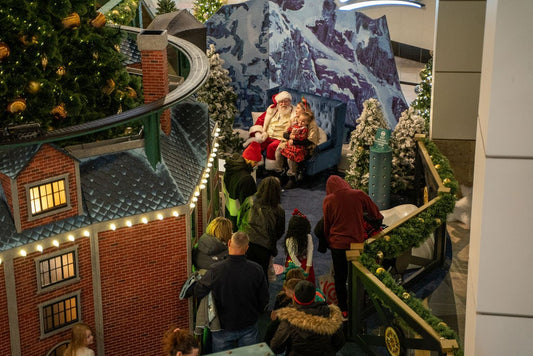In Kehler Liddell Gallery’s reflections, the works of artists Liz Antle-O’Donnell, Ana Henriques and Mark St. Mary weren’t created to reflect one another, though in some ways they do.
The most obvious resemblance between Antle-O’Donnell and Henriques is their medium. Both work in linoleum print and paper collage, but to very different effect. Among Antle-O’Donnell’s series of circle collages on the theme of home, the three largest appear to tell a little story. Featuring repeating black-and-white prints of three houses in which Antle-O’Donnell has lived, they generate thoughts of movement—the literal movement of the artist from one house to another and the spinning sensation created by the repetition of the same image around the circular format, as though driven there by centrifugal force. Adding to that kinetic sense are birds that cluster or fly in patterns or, in the case of the third circle in the series, settle into a central web of tree branches that form an intricate knot as if to anchor the families—both birds and people—in place.
sponsor message
Henriques’s paper works employ bolder colors and more relaxed lines. She leaves pencil strokes visible and cuts peek-a-boo holes, then stacks them loosely. Shadows are cast in the gaps between paper layers, themselves becoming lines that give the finished pieces deeper dimension. In forest II, a night landscape of black trees is mirrored blue in a river or pool at their roots. It’s a fantastical world of four fuchsia moons, some of which reflect oblong in the water below. Henriques plays with the shapes of water in many of her collages along with other natural elements—beaches, trees, mountains, suns and moons—and sometimes stamps them with fruity, leafy shapes. Unlike Antle-O’Donnell’s formally balanced circles, Henriques’s work feels improvisational, her spaces fluid and evolving.
Enter into this two-way conversation in paper the photographs of Mark St. Mary. Juxtaposing his images with these collages draws more attention to the layers and textures he’s captured. Some are identifiable, like slushy tire prints cut through snowy pavement. Others are more abstract. In Texture Study #806, for example, coppery folds are reflected in a cool blue metallic surface. Each of St. Mary’s photographs is labeled as a study in texture or color or pattern, although many address all three.
Color Study #2306 captures the gorgeous, sharp image of two clumps of seaweed washed up on the beach and composed from above by the photographer’s keen eye. They’re framed just as they landed, embedded in the sand, which has been rippled gently by receding water. The two clumps of golden vegetation are accentuated by green tendrils curving toward the edges of the image as if to balance it. Yes, this is a beautiful study of color—shades of brown and tan, gold and orange and green—but it’s also tactile. The weeds are ridged and bubbled and tangled, the sand is finely grained and delicately carved.
Many of St. Mary’s images, like this one, depict ordinary things—ladders hanging horizontally on a vertically sided barn, an arched stone wall beside one that’s stacked—but always in a way that encourages the viewer to step closer. When you do, you may notice a scatter of black berries or nuts on the ground or tiny green plants clinging to lichen-crusted mortar.
Winter afternoons are a good, quiet time for a visit to the gallery, and the work of these three artists gives visitors to Kehler Liddell plenty of space and cause to reflect.
reflections
Kehler Liddell Gallery – 873 Whalley Ave, New Haven
Thurs-Fri 1-6pm, Sat-Sun 11am-5pm through February 6
(203) 389-9555
www.kehlerliddellgallery.com/current
Written and photographed by Kathy Leonard Czepiel.








